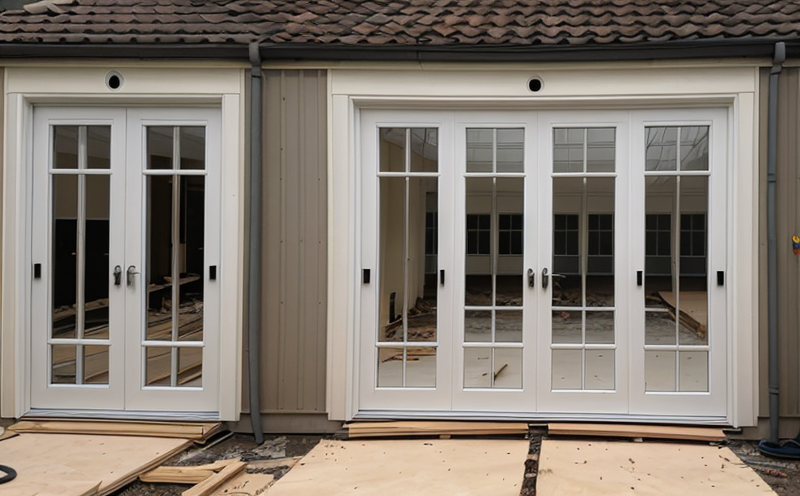Certification and Compliance Testing of Fire Windows
In today’s fast-paced world, fire safety is a critical aspect of any building design. Ensuring that doors, windows, and partitions can withstand the rigors of a fire scenario is essential for protecting lives and property. This service specializes in the certification and compliance testing of fire windows, ensuring they meet the stringent requirements set by international standards.
Fire windows play a crucial role in maintaining structural integrity during a fire event. They are designed to resist heat transmission, maintain their shape and structure, and prevent smoke and flames from spreading throughout the building. This service uses state-of-the-art equipment and follows rigorous protocols to test these windows under extreme conditions.
The testing process begins with the selection of appropriate specimens for evaluation. These specimens must adhere to specific dimensions and materials as defined by relevant standards such as ISO 14693-2 or ASTM E1380. Once selected, the windows undergo a series of tests aimed at assessing their performance under various fire exposure scenarios.
One key aspect of this service is the use of real-world test parameters that closely mimic actual fire conditions. This includes controlled heating rates, temperature gradients, and duration times which are critical in determining the true performance of the windows. The testing apparatus used for these evaluations ensures precise control over environmental factors to provide accurate results.
Another important factor is specimen preparation. Prior to conducting any tests, the windows undergo thorough cleaning and conditioning processes to ensure they start from a consistent baseline. This step is crucial in eliminating variables that could otherwise skew test outcomes. After preparation, the windows are placed into the testing apparatus where they face simulated fire exposures.
The instrumentation used during these evaluations includes thermocouples for measuring internal temperatures, pressure gauges for monitoring internal pressures, and cameras for capturing visual data throughout the duration of the tests. These tools allow us to gather comprehensive data on how each window performs under stress conditions.
Once testing is complete, detailed reports are generated summarizing all findings. Compliance with relevant standards such as ISO 14693-2 or ASTM E1380 is verified based on these results. If any discrepancies exist between the tested performance and required specifications, corrective actions can be recommended to bring products into full compliance.
Testing fire windows not only ensures safety but also supports regulatory requirements across multiple jurisdictions around the globe. By adhering strictly to international standards like ISO 14693-2 or ASTM E1380, this service helps clients meet local regulations while demonstrating their commitment to quality and safety.
In conclusion, certification and compliance testing of fire windows is an indispensable part of modern construction practices. It provides peace of mind knowing that critical components like doors, windows, and partitions are capable of performing as expected during a fire emergency. This service ensures that every product meets the necessary standards, thereby contributing to overall safety and security.
Applied Standards
This testing adheres strictly to international standards such as ISO 14693-2 and ASTM E1380. These standards provide clear guidelines on the performance criteria that fire windows must meet, ensuring consistency across different markets.
ISO 14693-2 specifies the test methods for fire resistance of doors, windows, and partitions. It outlines the procedures for exposing specimens to controlled fire environments to evaluate their ability to resist heat transmission, maintain structural integrity, and prevent smoke and flame spread.
ASTM E1380 provides additional guidance on testing specific types of fire window assemblies. This standard focuses on evaluating the performance of these assemblies when exposed to intense flames over extended periods, emphasizing both short-term and long-term stability.
Scope and Methodology
| Step | Description |
|---|---|
| Select Specimens | Pick specimens that meet the required dimensions and materials as per ISO 14693-2 or ASTM E1380. |
| Prepare Specimens | Clean and condition specimens to ensure consistency in starting conditions. |
| Place in Testing Apparatus | Position the prepared specimens into the testing apparatus designed for fire exposure simulation. |
| Capture Data | Use thermocouples, pressure gauges, and cameras to monitor internal temperatures, pressures, and visual data during tests. |
| Analyze Results | Evaluate the performance of each specimen against specified criteria outlined in ISO 14693-2 or ASTM E1380. |
| Generate Reports | Create comprehensive reports detailing test results and compliance status with relevant standards. |
Why Choose This Test
Choosing certification and compliance testing of fire windows is essential for several reasons. Firstly, it ensures that your products meet stringent safety regulations, which can help avoid costly legal issues down the line. Secondly, passing these tests demonstrates a strong commitment to quality and reliability, enhancing your brand's reputation among consumers.
Moreover, this service provides valuable insights into potential improvements needed for non-compliant specimens, helping manufacturers refine their products before final certification. Finally, by selecting this testing option early in the product development cycle, you can save time and resources compared to addressing compliance issues later in production.





